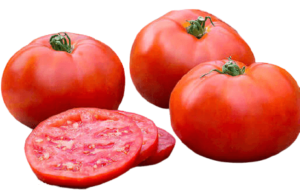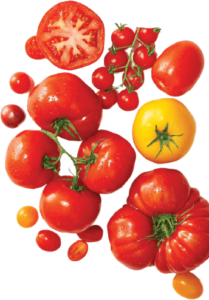Tomatoes
Overview:
Tomato belongs to the genus ‘Lycopersicon’ of the family ‘Solanaceae’.

Tomatoes have been included in the nightshade vegetables. It is one of the popular vegetables in most countries.
It is an appetizing and Tasty fruit and vegetable. It has all the qualities of fruit and can be eaten without cooking like a fruit. Although It is a fruit, It is known all over the world as a vegetable and widely used as a vegetable.
Tomatoes, which are a lot of vitamins and minerals, are in great demand as vegetables and salads. Most of the fruits are eaten as a salad. The fruit contains a sufficient amount of calcium, manganese, vitamin A and vitamin C. Eating the fruit increases red blood cells and eliminates anemia.
These are a lot of iron and alkalis which lot of healthy nutrients. It has a greater ability to make blood than expensive fruits such as apples, oranges, and grapes. Its leaves and immature fruit contain Tomatine which can be highly toxic. However, the ripe fruit does not contain Tomatine.
The fruits are being cultivated in large quantities all over the world in both season and off-season. It is the second most-produced vegetable crop after potato. Because tomato is a very nutritious vegetable.
Tomato recipes
Roasted tomato:
Roasted tomatoes bring some great flavors, but it actually makes them healthier. The recipes are delicious, healthy. The recipes can be stored in an airtight container in the refrigerator. The freezing tomatoes Can be eaten for 1-2 weeks.
Soup:
Tomato soup is a recipe that includes cream, chicken, other parts of vegetables and is used as a primary ingredient in meat. It can be served hot or cold and can be made in a variety of ways.
Commercially prepared soup is available in a variety of concentrated and dehydrated powders.
Cooking:
Tomato sauce is also common as a cooking ingredient in food. Cooking ripe and unripe The fruit is very tasty to eat.
Stewed tomato:
A very tasty stewed recipe can be made with fresh ripe fruit, salt, pepper, butter and sugar.
Different types of tomatoes

- Beefsteak Tomatoes
- Better Boy Tomatoes
- Black Krim Tomatoes
- Brandywine Tomatoes
- Cherry Tomatoes
- Campari Tomatoes
- Celebrity Tomatoes
- Cherokee Purple Tomatoes
- Early Girl Tomatoes
- Fourth of July Tomatoes
- Grape Tomatoes
- Great White Tomatoes
- Green Zebra Tomatoes
- Jubilee Tomatoes
- Juliet Tomatoes
- Heirloom Tomatoes
- Pear Tomatoes
- Plum Tomatoes
- Roma Tomatoes
- Rutgers Tomatoes
- San Marzano Tomatoes
- Super Sweet Tomatoes
- Pear Tomatoes
- Vine Tomatoes
- Yellow Tomatoes
Nutrients per 100 grams of tomatoes are –
Water: 93.1 g
Protein: 1.9 g
Fat : 0.1 g
Minerals: 0.8 g
Fiber: 0.6 g
Sugar: 3.8 g
Sodium : 45.6 mg
Potassium : 114 mg
Copper : 0.19 mg
Sulfur : 24 mg
Chlorine: 36 mg
Thiamine: 0.06 mg
Riboflavin: 0.01 mg
Nicotinic acid: 0.4 mg
Vitamin -C : 31 mg
Magnesium: 15 mg
Oxalic acid: 2 mg
Phosphorus: 36 mg
Iron : 1.8 mg
And others ingredients have nutritional value as well as medicinal value.
Health Benefits:
- Tomatoes contain a special ingredient called Lycopene, which can effectively prevent cancer of the lungs, stomach, pancreas, colon, breast, bladder, prostate and other organs.
- It contains Lycopene is effective in the body’s immune system, preventing heart disease. The fruits are very effective in controlling heart disease and high blood pressure.
- Regular eating of the fruit is very effective and it can reduce cholesterol levels, reduce the risk of heart attack and the risk of stroke.
- Those who are always in a weak state or feel weak would benefit from eating ripe fruit in the morning and afternoon or eating juice.
- Those who have hard stools, gas in the stomach and digestion is less, they can eat one / two tomatoes in the morning and afternoon then will reduce the problem and will get a lot of benefits. Regular eating of the fruit keeps the stomach healthy and strong.
- Those who have various skin diseases will benefit by eating tomato salad or eating juice.
- Those who have less appetite and hunger in their mouth can eat the fruit regularly then will get a lot of benefits.
- It helps to keep the urinary tract safe. As a result bladder infections and stones do not form.
- Those who have hemorrhoids and longtime fever will benefit from eating the fruit regularly.
- Pregnant Women and those who have children will eat the fruit regularly to increase physical and mental strength. Which will be very beneficial to mother and baby. Children are fed a little tomato juice three times a day and the child will develop a healthy and strong body.
- The fruit is quite beneficial for diabetes. It controls the level of glucose in the blood.
- The fruit contains vitamin-A which improves eyesight.
- Vitamin-K is present in tomatoes which helps in building strong bones.
- It provides essential antioxidants in the body which protect the body cells from damage.
- The fruit is especially beneficial for skin, hair and teeth.
- Tomato juice is very beneficial for muscle recovery after exercise or physical exertion more than any other soft drink.
How to Make a Garden?
Make a Seedbed
Tomatoes are cultivated by making seedlings.
For this, seeds have to be sown in the seedbed and seeds have to be made there. Germination should be checked before sowing in the seedbed.
Many times the soil in the seedbed may contain some pathogens. When soil gets the water then those pathogens become active.
These pathogens can attack the seeds. As a result, the seeds die. Therefore, it is better to purify the soil in the seedbed.
For success in cultivation, the seeds have to be refined first. Seeds can often contain viruses, fungi, and bacterial germs.
Seeds can be purified in several ways.
It is easy to purify the seeds by soaking them in hot water.
Soaking the seeds in hot water for 30 minutes kills viruses, bacteria and fungi on the seeds. The wet seeds should be picked up in the sun-dried then sown.
Seeds can also be treated with fungicides.
Keeping the soil of the seedbed leave to cultivate for two weeks then kills many germs in the soil and purifies the seedbed.
Seedlings
Tomatoes can also be grown by sowing seeds directly on the land.
However, to get good results quickly, seedlings should be prepared separately in the seedbed and planted in the mainland.
For this, the seedbed should be prepared by clearing the high sunny places and cultivating the soil well.
After cultivation, the soil should be leveled and a bed 1 meter wide should be made.
It is better to make the bed 3-5 meters without being too long.
Seeds can be sown in the seedbed by sprinkling. For scattered sowing, it usually takes 100-150 grams of seed per square meter of the seedbed. It takes 7-14 days for seedlings to germinate from seed.
Land prepared for cultivation
The land has to be cultivated 4-5 times and the soil has to be Crunchy. Its cultivation requires making beds 20-25 cm high and 230 cm wide. To facilitate irrigation, a 30 cm ditch has to be placed between the two beds.
Distance for planting seedlings
25-30 days old seedlings should be planted in rows at a distance of 60×40 cm in each bed.
Necessary action
The stick is very essential when the tree is growing. Make a cage if the tree continues to grow. The trees are tall and flexible stalks themselves cannot stand straight.
The trees would be especially heavy with fruit. The plants without cages and sticks will spread on the ground. And most of the fruit will be in the soil too – these will be infested with pests, diseases and rot.
Irrigation can also be given if necessary. Appropriate action should be taken to cure viruses and other diseases. Even if seen insects then the right action must be taken.
Crops Collection
The fruit is harvested in 2-4 months depending on the planting time. It can be picked both ripe and unripe.
References: